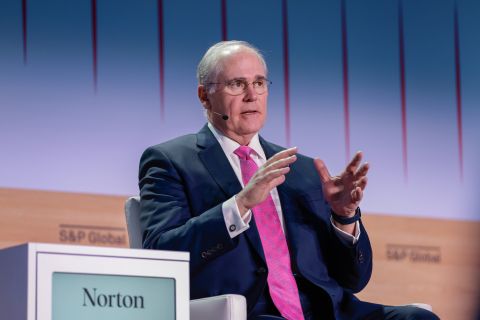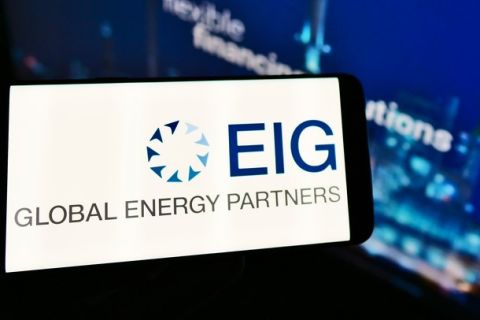Exit, stage left: numerous gas mega-marketers. Enter, stage right: gas producers who have to fend for themselves to sell gas and manage risk. Recent upheavals in the gas marketing and hedging world are changing the landscape for all parties. Concerned with the creditworthiness of the middlemen, some producers are selling directly to large end-users and utilities. Others are marketing the gas of fellow producers, particularly the small to midsize producers that don't have an in-house marketing team. Some have banded together. A consortium of five Alberta-based producers, whose output is a combined 750 million cubic feet a day, have formed their own marketing co-op, Calgary-based Energy Trust Marketing Ltd. ETML will operate as agent for its producer-owners and for third parties in all North American markets. New consulting firms have popped up to help producers sort it all out. Even Cliff Hare, former president of Dynegy's marketing and trading unit, has formed a new company, Eagle Energy Partners, to market gas and power. And, some midstream companies are moving beyond gathering to add marketing to their offerings. The timing of the departure of the large merchants was perfect for some producers, at least in the short-term. The merchants wanted out of fixed-priced contracts as commodity prices were rising, allowing producers to take advantage of the better gas-price market. "Producers were more than willing to say OK, to increase their netbacks," says J.C. Whorton, executive vice president of Denver-based StratCom Advisers, which provides risk-management consulting services to producers. But, since the market turmoil began, gas demand has declined by at least 4 billion cubic feet (Bcf) a day due to the weather, economic downturn in manufacturing and fuel switching. According to Whorton, the next year will test whether or not producers can protect their current margins. "Just like the cash market, there is a supply and demand market for hedge instruments, because that was the bread and butter of the merchants. If the producer wants to buy floors or collars, these will be much more expensive." The exit of the dominant market-makers-Enron, Dynegy, Williams, Aquila, Duke Energy, Mirant-has reduced the number of market participants, trading volume and liquidity. Some producers applaud their departure, saying it helps remove some pricing gamesmanship, even manipulation, that led to price volatility. Producers say the gas market is returning to basics, with far less speculative trading and more emphasis on asset-backed transactions. Now, large gas producers such as BP, ConocoPhillips and Shell's trading arm, Coral Energy, have risen to the occasion. ChevronTexaco markets its own gas, now that it has dissolved its arrangement with Dynegy. ConocoPhillips not only markets its own production, but buys third-party gas for resale, and markets some third-party gas for other producers for a fee. "We have experienced a recent nominal increase in the marketing of natural gas on behalf of third parties, however, this aspect is a small portion of our natural gas marketing business," says Rich Johnson, company spokesman. The independents One of the surviving mega-marketers recently lost a major account when Apache Corp. announced it will end its arrangement with Cinergy and handle the job itself. Apache's new gas marketing team, headed by vice president Janine McArdle, expects to handle some 1.2 Bcf a day, including gas produced by companies with some working interests in Apache-operated wells. Apache says it will only trade the physical commodity. "Five years ago, Apache was producing around 500 million cubic feet of gas per day in the U.S. and Canada and our arrangement made sense," says chief executive officer Steven Farris. "Today, with more than 1 Bcf per day of production in North America and significant changes in the gas marketing arena, it is time for Apache to market its own gas." Gas producers had abrogated their positions to gas marketing companies, and producers need to take that back, Farris adds. Some traders, through bogus trades and price manipulation, had damaged gas markets by creating volatility, which undermines the ability of consumers to set long-term budgets, Farris says. Adds McArdle: "We want to get closer to our customers and provide them with the services they need. In this new era of gas marketing, we believe more direct interaction between producers and consumers is good for both ends of the value chain." Apache, a leading critic of the price indexes that have come under fire recently, expects to use a variety of pricing tools to market its gas. Devon Energy markets all of its equity gas-1.6 Bcf a day in the second quarter-as well as some third-party gas from those who own working interest in its properties, and some third-party gas that uses its transmission and processing facilities-a legacy of its Mitchell Energy acquisition. Burlington Resources also markets its own gas, about 1.9 Bcf a day. It estimates that of the 400 companies in its database of gas purchasers, about 10% have exited the business, or are weakened to the extent that Burlington prefers not to sell to them. Spokesman James Bartlett says that includes about a half-dozen firms that served as market-makers and purchased 50% of the company's gas production. To compensate, Burlington, like many others, is more frequently marketing directly to end-users such as gas-distribution companies, electric utilities and manufacturers. But Burlington will market gas to a relatively risky purchaser, typically to preserve market access. "In those cases, Burlington may ensure that it already owes the purchaser more for other services rendered than the dollar value for its gas; and the purchaser may also be required to post a bank letter of credit covering two months of anticipated sales," Bartlett says. XTO Energy says an increasing percentage of its gas sales is "migrating to the bigger players" because of its strong aversion to risk and the concerns it has over the credit-worthiness of smaller market participants. The Fort Worth-based company produces about 660 million cubic feet of gas per day. Even in the heyday of the merchants, industry counterparties were minor participants in XTO's risk-management mix, as the company instead used its lenders or financiers primarily as the counterparty. Tulsa-based Latigo Petroleum, which also markets its own gas, is concerned about reduced liquidity and competition for gas at the wellhead. "Fewer marketing companies are either able or willing to purchase natural gas at the wellhead and as a result, we have seen a dramatic and sustained increase in the basis for nearly all of the major intrastate and interstate pipelines in the Midcontinent," says chief financial officer Mark Womble. "This nearly 160% increase in the basis, coupled with a similar increase in the fees charged by the few remaining marketers purchasing at the wellhead, does give us pause for concern, particularly if gas prices fall to more historical levels," he adds. "Although the number of acceptable intermediaries has lessened the liquidity and probably widened the bid-ask spread, we have been able to find adequate and acceptable markets that we are comfortable with for hedging a portion of our price risk using financial instruments. While this practice does not provide as perfect of a hedge as a physical hedge or dedication of gas, it does provide an offset to price volatility." Houston-based Laredo Energy is an example of a producer that markets its gas through a third-party, Tri-Centrol, which acts as an agent for the company, but never takes title to the gas. Laredo president Glenn Hart scoffs at the suggestion that producers need an intermediary for risk management. "Nonsense," he says. "What makes anyone think producers and consumers are not capable of managing the risks associated with their businesses without the 'help' of these misguided enterprises? The physical markets have ample liquidity, and producers are perfectly willing to use derivative hedges. In fact, the producer community has long been suspicious about how these companies manipulated the markets for their own benefit." Midstream players Dallas-based Camden Resources markets most of its gas directly, but utilizes Crosstex Energy Services when that company can add specific value to the sale. Camden has been able to tie most of its product pricing to a fairly stable pricing index, the Houston Ship Channel, says Camden executive vice president Bryant Patton. Crosstex, a newly public midstream company specializing in gathering, transmission, processing and treatment, has gained a number of producer clients under agency agreements where it handles risk management and marketing. "Previously, these producers were actively pursued by the large merchant-energy companies. However, even before the latter exited the business, many were handing off small packages, deemed too small for the large merchants, to companies like Crosstex," notes James Wales, executive vice president. "We continue to see new opportunities to fill the void left by the large merchant companies," Wales says, "but under our totally risk-adverse policies, we are somewhat limited and therefore very careful about the relationships we pursue. Crosstex has become much more proactive in targeting credit-worthy counterparties and we may increase our efforts to pursue opportunities further down the pipe to serve industrial and LDCs directly." Liquidity in the paper trades for fixed-price swaps has been affected and as a result, it has become more difficult to execute small lot trades. Counterparties have increased their margin for these trades, Wales explains. "We see several large producers, such as BP and ConocoPhillips, anxious to step into the space created by the exodus of the large energy merchants. They are perfectly situated to take on the performance obligation of delivering a secure supply." Coquest Structured Products, which was formed in October 2001 to assist small and midsize producers with their risk-management needs, is among several companies, already providing some services to producers, that is considering expanding those services to include gas marketing. "A lot of people are taking a long look at it," says Norman Young, vice president and senior trader for Coquest Structured Products. Young was convinced two years ago that small producers were an underserved niche, but he concedes the opportunities now are much greater than he envisioned. There are still a lot of very small producers who may only want to hedge as little as one contract a month, that have been overlooked by the risk-management community, he says. But, with the credit crunch that has infested the industry, Coquest doesn't extend credit and counterparties must post margin dollars or provide a letter of credit. New technologies A growing group of producers, handling their own risk management, are turning to new technologies for assistance. Once such tool is Internet-based Kiodex, which is designed to assist users in managing energy-price risk management, measuring risks, and processing-related accounting reports. Kiodex integrates pricing tools, market data, risk reports and position-keeping into a single application. Among its E&P clients are Devon Energy, Forest Oil, Encore Acquisition, Mission Resources, Gryphon Exploration and Murphy Oil. Ann Kaeserman, chief accounting officer, Mission Resources, says, "Kiodex gives us negotiating power that we never had before. It takes just 15 minutes to input and test our hedging strategies. In doing so, we have realized as much as 25-cent-per-Mcf margins in collars over what we would have taken from the counterparty." Houston-based Gryphon Exploration recognizes the ability to track and value every hedge from inception through maturity, an invaluable asset, says William Flores, Gryphon chief financial officer. It selected Kiodex to seamlessly document each step of the hedging process and related reporting. Veteran risk manager Jerry E. Brown, managing director of marketing for Shamrock Energy LLC, Shreveport, Louisiana, says, "Organizations that have a legitimate requirement to make a market, by providing both bid and offers for their region or asset base, have been restricted to such an extent that it makes it difficult for producers and consumers to execute sensible hedges with natural counterparties. "This forces the producers and consumers to do their own hedging, utilizing derivative instruments as opposed to accepting prepackaged OTC products from their physical counterparties." Gas marketing has gone full circle from its beginnings, when many companies consisted of only a handful of employees, to the behemoths that emerged prior to the collapse of Enron, he adds. Now, several four- to six-person shops are being created, where instead of stressing volume as the mega-marketers did, they are again stressing customer service, creativity and flexibility.
Recommended Reading
Which Haynesville E&Ps Might Bid for Tellurian’s Upstream Assets?
2024-02-12 - As Haynesville E&Ps look to add scale and get ahead of growing LNG export capacity, Tellurian’s Louisiana assets are expected to fetch strong competition, according to Energy Advisors Group.
‘Unexpected’ JV to Move Permian NatGas to Gulf Coast LNG Terminals
2024-03-26 - A trio of midstream companies—Enbridge, Whitewater and MPLX—will work together to build infrastructure to transport Permian Basin natural gas to Gulf Coast LNG terminals.
EQT Sees Clear Path to $5B in Potential Divestments
2024-04-24 - EQT Corp. executives said that an April deal with Equinor has been a catalyst for talks with potential buyers as the company looks to shed debt for its Equitrans Midstream acquisition.
ONEOK CEO: ‘Huge Competitive Advantage’ to Upping Permian NGL Capacity
2024-03-27 - ONEOK is getting deeper into refined products and adding new crude pipelines through an $18.8 billion acquisition of Magellan Midstream. But the Tulsa company aims to capitalize on NGL output growth with expansion projects in the Permian and Rockies.
EIG’s MidOcean Energy Acquires 20% interest in Peru LNG
2024-02-08 - On top of acquiring a 20% interest in Peru LNG, MidOcean Energy is also in the process of acquiring interests in four Australian LNG projects.





